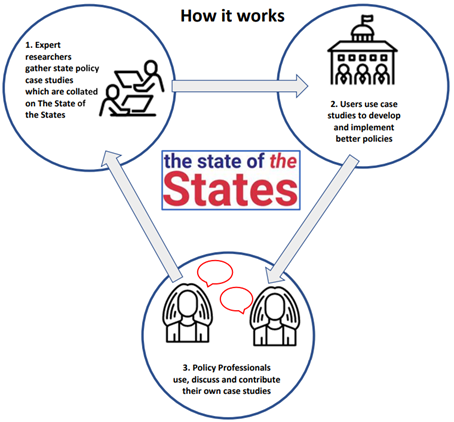 State and local policymakers in the US often face problems in having enough information to do their jobs well. Chris Gilson outlines a new tool developed by the LSE Phelan US Centre to help these policymakers to better share information about which policies work and which do not – The State of the States.
State and local policymakers in the US often face problems in having enough information to do their jobs well. Chris Gilson outlines a new tool developed by the LSE Phelan US Centre to help these policymakers to better share information about which policies work and which do not – The State of the States.
For decades commentators and academics have declared that modern society is in an “Information Age”; perhaps more properly, it’s more apt to talk about a “Data Age”. Either way, decision-makers are often deluged with, or even seemingly drowning in, data.
One major success story from the information/data age was the quick rise of the Google search engine – Google’s parent company, Alphabet is one of the most highly valued companies in the world. The secret to Google’s success was that it made sense of the content on the nascent World Wide Web. Google was able to index and search millions of pages, becoming the “front page of the internet” within a few short years of its 1998 launch. Even following the rise of social media, without tools like Google, the online world would be largely inaccessible to most (over 30 percent of online news traffic in the UK is via Google). From infographics on social media to wearable self-tracking for health and exercise, society is increasingly accepting of the role of data in people’s lives.
Policymakers across all levels of government need information and data to do their jobs well – from legislators deciding which measures are likely to be effective in fulfilling their election promises to voters, to the civil servants charged with implementing these measures and the policies they include. But where do policymakers get their information?
The rise of digital in government
Just like society more widely, governments – including state and local governments – have been affected by the growth of digital connectivity, with the rise of e-government where citizens are able to access public services online rather than via traditional paper forms. But digital technologies have had a wider impact on government than just in the way they provide services. They are also a path for information to flow in and out. Recent research has found that the growth of broadband access may help explain why geography has become less and less important in the spread of policy ideas between different states. Relatedly, public employees are better able to learn and their ability to do their jobs can be improved via e-learning platforms, as well as via the more durable record-keeping that can come with e-government.
How digital tools can help policy information deficits in US state and local government.
As I outlined in my last post, legislators and policymakers often face three key challenges to having enough information to do their jobs well:
- Increasingly limited resources mean they are too busy to learn well, especially in an often information or data saturated environment.
- A lack of or declining, institutional memory means they don’t know enough; and
- Their information networks can be limited or dependent on political similarities.
Alongside the rise of digital in government, a plethora of tools have also developed to bring together and share knowledge about government in the US. Launched in 2008, GovLoop works as a social network to connect those working in and around US federal, state, and local government. The social learning network, apolitical manages online communities, courses, and events for those working in government across the world. FiscalNote provides organizations with real-time information about government policies and legislation as well as webinars, white papers, and blog articles. However, while these tools have grown in popularity, they either only partially address the three policy information challenges facing state and local government that I’ve outlined, or do not address them at all.
As I mentioned, the success of digital tools like Google in the late 1990s and early 2000s was in their ability to organise the vast volumes of information available on the internet in a way that was meaningful and helpful for users. With this in mind, over the past few years the Phelan US Centre, has been developing a digital project to organise and parse information about state and local policies that addresses directly the information challenges facing policymakers – The State of the States.
In conversations with policy practitioners in the US, they’ve told us that they want to learn from their peers in other governments about best practices for addressing policy problems, but that there is no systematic way for them to do this – beyond simply picking up the phone and calling those working on similar policies in other locations. In response, we’ve created The State of the States as a subscription service which curates and provides this information for policymakers and governments.
The State of the States is based on the free online resource, created by the Phelan US Centre in 2018 which showcased key statistics and data about policy and politics in each of the 50 US states. This platform went on to win a Guardian Universities Award for Digital Innovation in April 2019.
How the State of the States works
The State of the States now has two main components, 1) a free, map-based database of US state information, and 2) a subscriber access database of case studies covering state and local policymaking.
The case study database acts as a ‘policy brain’ for those working on state and local policy issues. Using either a US map (Figure 2) or a list users can select case studies related to key policy areas by state – we have launched the platform with case studies on homelessness, unemployment, and COVID-19 responses.
Figure 1 – The State of the States case study selection

Through our case studies (Figure 2), users can see the policy measure’s effectiveness quickly using narrative titles, summaries and then descriptions of the problem and solution approach and implementation. We also provide further resources on the impact and effectiveness of the policy, including links to external sources such as audit reports and media reporting.
Figure 2 – Example of a case study on The State of the States

An important built-in feature of the case studies held on The State of the States is the ability for users to comment and vote on the usefulness of each case study. This encourages dialogue and information exchange as well as a kind of peer review of the information in each case study. At the moment, case studies are researched and written-up by The State of the States team, but we would like to expand our case studies through content written by our users (see Figure 3).
Figure 3 – The State of the States encourages dialogue and discussion between users

How does The State of the States help solve problems faced by those working in state and local government?
As a subscription-based tool, The State of the States helps democratise policymaking. Policymakers don’t have to simply rely on traditional methods of information gathering such as professional networks, conferences and seminars or lobbying from corporations or other groups. Crucially, The State of the States outlines case studies which show which policies have been effective and those which have not, both in terms of their implementation and their impact.
The State of the States provides users with action-oriented information to make positive changes and provides them the ability to make connections with others working on the same issues. It gives anyone working in policymaking the chance to become a policy entrepreneur, arming them with the information – and the connections – they need to make the case about a specific policy approach or solution. The platform’s aim is to reduce the chance of policy failure, as users can easily get an evidence-based picture of how a specific policy design or a policy’s implementation has played out in other states, counties, or cities.
What’s next?
The State of the States is in its early stages of development and is an ongoing project. We’d like to hear from more people working in state and local government in the US and elsewhere to find out if they think the platform is useful for them, what they need from it, and the information challenges they are facing. We’d like your help to grow the platform and to partner with organizations working on similar problems and tools to improve US state and local policymaking.
- Want to get in touch about The State of the States project? Email Chris Gilson at c.h.gilson@lse.ac.uk.
- The author would like to acknowledge the contribution of Jason Clark, the 2023-24 LSE Phelan US Centre Undergraduate Research Assistant for The State of the States project in assisting with the literature review which contributed to this article.
- Featured image credit: Photo by Luca Bravo on Unsplash
- Please read our comments policy before commenting.
- Note: This article gives the views of the author, and not the position of USAPP – American Politics and Policy, nor the London School of Economics.
- Shortened URL for this post: https://wp.me/p3I2YF-dJ1






